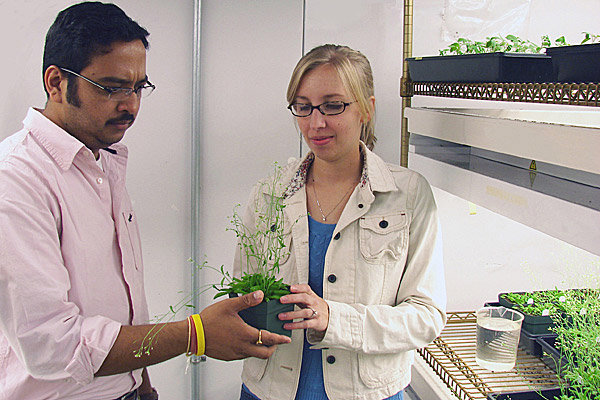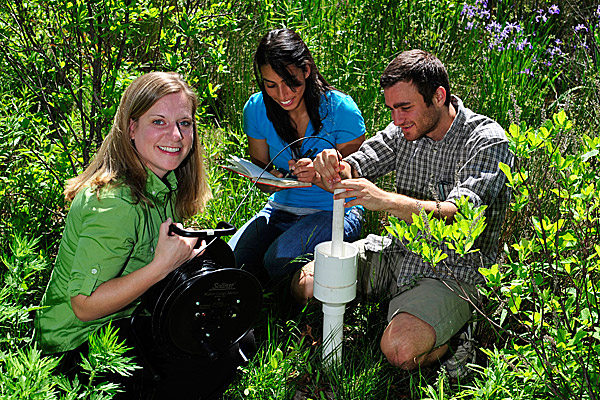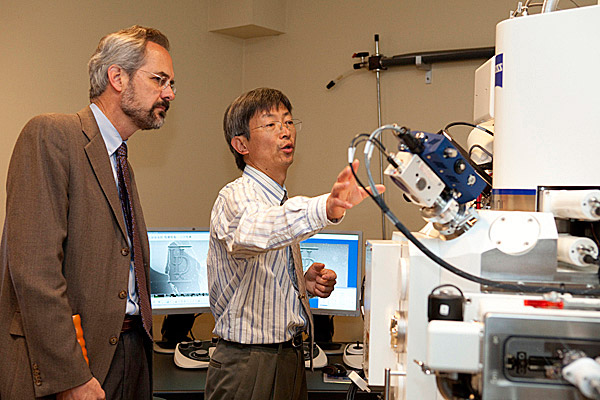


Seeds of progress
Delaware EPSCoR announces 2012 seed grant recipients
11:22 a.m., March 6, 2012--The Delaware EPSCoR program has awarded seven seed grants to University of Delaware faculty whose projects address current environmental issues within the state.
EPSCoR, the Experimental Program to Stimulate Competitive Research, is a federal grant program of the National Science Foundation (NSF) that helps states develop their research capabilities so that they may compete for further federal funding.
Research Stories
Chronic wounds
Prof. Heck's legacy
Seed grants are typically in the $50,000 range and help researchers set the stage for applications to larger federal funding programs. Seed grant proposals are solicited annually during the fall semester. The selections were made by a committee of five senior faculty affiliated with the Delaware EPSCoR program and two external reviewers representing the Delaware Department of Natural Resources and Environmental Control (DNREC).
This year’s funded projects are as follows:
Microbes that remove arsenic from rice
Rice is a staple in diets across the globe, but it is commonly contaminated by arsenic (As) in many developing nations. To solve this problem, University of Delaware scientists Harsh Bais and Janine Sherrier of the Department of Plant and Soil Sciences have proposed that the inoculation of rice with the bacterium EA106 will reduce arsenic accumulation within the edible portion of the plant, simultaneously improving quality and yield. Arsenic-contaminated rice represents a significant health risk to millions of people worldwide; in their research Bais and Sherrier plan to “systematically dissect the overall mechanism in As absorption and translocation in rice.” Their efforts will further probe the field of plant-microbial processes and how they may be used to agricultural advantage.
Sulfur metabolism in microbes
Thomas Hanson, associate professor of marine biosciences, and Sharon Rozovsky, assistant professor of biochemistry, have received funding to study the contribution of microbial activity in the sulfur cycle. Elemental sulfur is often used as a slow-release fertilizer and is both generated and broken down by the metabolic processes of certain microbes. The project will use nuclear magnetic resonance (NMR) spectroscopy to examine the synthesis and degradation of elemental sulfur by the bacterium Chlorobaculum tepidum. Their research will lay the groundwork for investigating the microbial metabolism of other elements. In the future, Hanson and Rozovsky’s results may influence bioremediation strategies, possibly allowing chemical spills to be removed by nanoparticles.
Iron oxidation by microorganisms
A group from the Department of Geological Sciences will study the link between microbial iron (Fe) oxidation and the characteristics of groundwater-surface water interfaces at the Christina River Basin Critical Zone Observatory (CRB-CZO). The interplay between chemical fluctuations and microbial metabolisms at groundwater-surface water interfaces allows microbes to process and transform contaminants and minerals before the water flows into streams, rivers and oceans. Iron-oxidizing microorganisms are of particular interest because they liberate organic carbon from CO2. Clara Chan, assistant professor, and Holly Michael, assistant professor, will build on current research at the CRB-CZO to demonstrate the presence of iron-oxidizing microbes and correlate that presence with specific hydrologic factors.
Impact of terrestrial phosphorus on eutrophication in the Chesapeake Bay
Principal investigator Deb Jaisi, assistant professor, and Donald Sparks, S. Hallock du Pont Chair of Soil and Environmental Chemistry, both of the Department of Plant and Soil Sciences, will investigate the concentrations of terrestrial and nonterrestrial phosphorus (P) input into the Chesapeake Bay over time. The prevailing notion is that the level of nonterrestrial P has remained constant since early civilization, and thus terrestrial P is the sole culprit in the eutrophication (increased concentrations of nutrients which result in algae blooms and fish kills) of the Chesapeake Bay. However, observed changes in the bottom water environment indicate that this is unlikely. Their study will influence future management strategies to limit nutrient pollution, with regulations possibly addressing both terrestrial and nonterrestrial P input. Sparks is director of the Delaware Environmental Institute.
Effect of iron availability on harmful algae
Lead investigator Kathryn J. Coyne, assistant professor of marine biosciences, and E. Fidelma Boyd, associate professor in the Department of Biological Sciences, will evaluate the role iron plays in biofilm formation between bacteria of the genus Vibrio and raphidophytes (a type of algae), which may increase the toxicity and abundance of the algae. They hope their investigation will resolve contradictory reports on these interactions. The project will provide insight into the recurring algae blooms in Delaware’s Inland Bays and the damage they cause. Coyne’s research is also expected to improve pathogen forecasting and to help local, state and federal agencies to establish microbial indices for human health risks.
Particle formation due to marine biota
New particle formation is a significant source of airborne particulate matter, which negatively impacts visibility, human health and global climate. Murray Johnston, professor of chemistry and biochemistry, and George Luther, Maxwell P. and Mildred H. Harrington Professor of Oceanography, will investigate whether gaseous emissions from marine biota (plant and animal life) cause new particles to form in the ambient air. Their study will focus on macro- and micro-algae in living and decaying states, as well as under bloom conditions. The goal of their research is to better understand the factors that affect air quality in coastal and marine environments.
'Sensor-on-a-chip' for monitoring air and water quality
Juejun Hu, assistant professor, and Chaoying Ni, associate professor in the Department of Materials Science and Engineering, are developing chip-scale sensors for the detection of organic, inorganic and biological species with minimal power consumption. By applying novel mechanisms, Hu and Ni plan to overcome the limits of conventional optical sensors and improve both the sensitivity and specificity of these “sensor-on-a-chip” platforms. If their work is successful, it may provide the basis for a network of sensors capable of monitoring air and water contaminants in real time.
Article by Jacob Crum
Photos by Ambre Alexander and Kathy F. Atkinson










